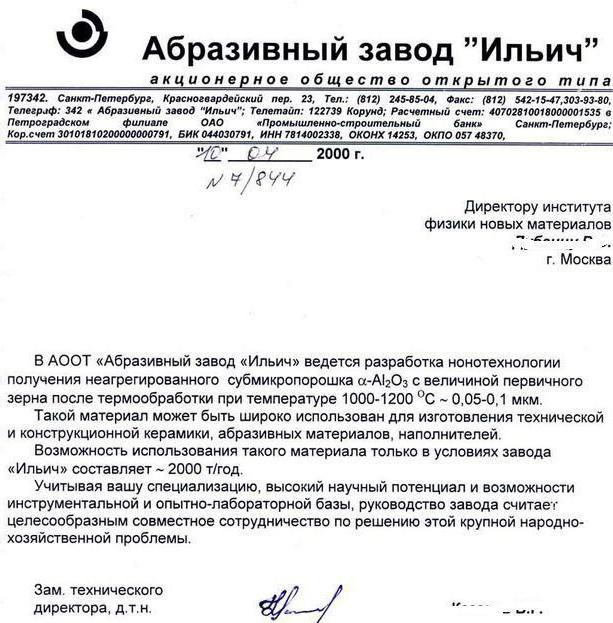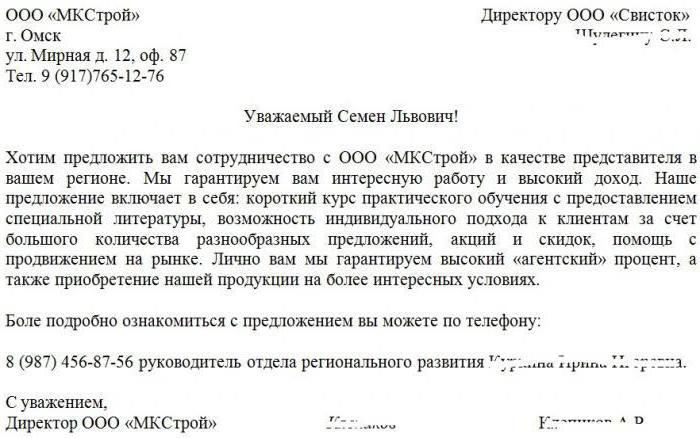An offer of cooperation is considered a document in which one organization makes an offer to a third-party company about possible joint work on favorable terms. The main goal of such a proposal is to interest the future partner and make him choose this organization. Let us consider in more detail how such proposals are compiled, what are their main features.
Who writes to whom?
A letter of invitation for cooperation is drawn up by an authorized employee who is engaged in business development or a similar direction. The text of such a letter must be agreed with the head of the organization. Similar proposals may be made by the head of the company.

The letter is drawn up in the name of the director of the company with which further cooperation is planned. Also, the addressee may be the deputy director or any person who deals with such issues and has the authority to make decisions on possible cooperation. But all business proposals for cooperation are ultimately considered by the organization’s management.
General rules
The most important thing to remember is that the offer is a kind of hook that should hook the potential partner. The text of the letter should be informative, interesting and competent. The ideal outcome for reading such a letter would be to request a quotation or price for goods and services.
Despite the fact that the proposal for cooperation (a sample will be presented later) is considered an official document, there is no standard form. A letter is drawn up in free form or according to a template that is developed in a particular organization, based on the tasks and capabilities of the enterprise.
When making proposals, you need to follow the elementary rules of the Russian language, office work and business ethics.

Before writing a letter, you should find out the details of the employee with whom communication is supposed.
So, the proposal will consist of:
- Heading (this stage is not mandatory, because a poorly composed heading may discourage you from reading the rest of the letter).
- Appeals (it is better to start this stage with the words "dear").
- The very offer.
- Signatures of the addressee.
Main part
How to write a proposal for cooperation so that the opponent does not consider other invitations? The main part of the letter should contain the essence of the whole proposal. Florid statements and blurry phrases, long and confusing sentences, as well as special terminology are inappropriate here. The essence of the letter is clear, concise and concise. Emphasis is placed on special features and an advantageous offer.

In the main part, the sender company needs to be mentioned, but it should be only the year from which it works and the main activities. At this stage, other information will be redundant.
You can also specify the current partners or clients of the organization who will certainly respond only positively about the company's activities.
At the end of the letter, you can give a link to the official website, which contains more detailed information about the organization, as well as other additional information not specified in the proposal.
The intonation of the letter should be more incentive than narrative. But the main thing here is not to go too far, to compose the text correctly, without imposing services and cooperation.
In the event that the text is long, but all the information is important for reading, it should be divided into paragraphs and highlight important points.So the perception will be complete, and the large text will be perceived easier.
The main idea of the letter or an important message should be located either at the beginning or at the end. The whole secret is that these parts are more deposited in the subconscious of the reader.
As practice shows, those who receive a letter of invitation for cooperation (sample below) are ready to spend no more than 60 seconds reading it, this fact should also be read when composing a letter.

Mandatory Information
When compiling a proposal, you must always remember the mandatory information contained in it. It:
- name of the organization that sends the letter;
- actual address and telephone number for contacting the contact person;
- surname, name, patronymic of the authorized person and his position;
- the main essence of the appeal.
Additional documents or references to legislative acts and norms that are directly related to the cooperation proposal may be attached to the proposal.
Registration
You can issue a letter in several ways:
- Write an offer by hand.
- Type the offer on the computer.

The first option, of course, is somewhat outdated, but in some cases it turns out to be the most effective, because there are leaders who do not accept new technologies and prefer to communicate and work “the old fashioned way”.
The second option is more familiar and convenient. Firstly, in electronic form there is probably a preparation of the official letterhead of the organization with the necessary details, and secondly, if the proposals are drawn up constantly, then there may be a ready-made letter template where you just need to substitute the addressee and, possibly, change some information that is correct in the specific case.
A proposal may be made in any number of copies, but at the beginning it necessarily contains an appeal, and at the end - the signature of the sender.
The date should be set only in situations where the offer contains promotions or special conditions that are active for a certain amount of time.
It is not necessary to register the offer of cooperation in the journal of outgoing correspondence.
How to “make” cooperate
Of course, to “force” does not mean to exert a physical effect on the person making the decision on cooperation. The example of a cooperation proposal that was presented earlier shows that the letter should encourage the opponent to make a positive decision.

To induce this, one organization only needs an incentive speech calling for cooperation, and the other company will need to offer a discount or a small fee for accepting the proposal.
Before writing letters, you need to study your opponent well: what he can agree to and what is unacceptable to him. Indeed, in one word or phrase, you can instantly spoil the idea of the whole company.
Do you need gratitude
Another important point of the proposal for cooperation is gratitude. At the end of such letters must necessarily be gratitude for the time taken and the letter read.
This indicates both the seriousness of the organization and elementary politeness for the time taken from the opponent.
Such letters will not contain thanks by default, as this is an individual approach of each organization to its potential partner or client.
Departure
So, what is the best way to send a letter of invitation for cooperation (sample provided earlier)?

This can be done in different ways, each organization chooses for itself a more acceptable and convenient option. Consider the most common:
- Email. This method is considered to be the simplest, quickest and most affordable. But the letter to the opponent can easily get lost, having got into the unwanted correspondence of the addressee. A similar method can be used only if the sender and addressee have established contact.Well, or send a letter "randomly", suddenly you are lucky and it will not be in the "Spam" folder.
- Post office. This method is considered the most reliable, since the letter in any case reaches the addressee. But it is also the most time-consuming, because everyone knows how slowly the Russian post works. Of course, if the newsletter is massive, then this method is clearly not suitable, it is better to use the first option.
- Fax. A slightly outdated, but still used method for sending offers. Also suitable for a specific offer of a particular company.
- Any method of a modern type of communication (instant messengers, social networks, etc.). Such a method is only relevant if the parties are well acquainted with each other and a written proposal is only a formality for further cooperation.
So, now you know what a letter of cooperation proposal is, how to compose and send it.